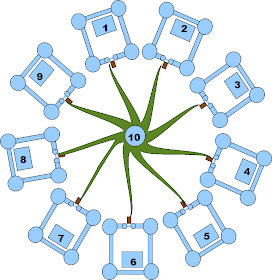 |
| This is our "Capture the Castles" board. The children helped design it |
Each child should have an equal chance at winning regarding what his or her skill level is. A recent game the children and I have been playing is one we call Capture the Castles. There are 10 castles to capture which are captured by putting that player's colored marker on it. The person with the most castles at the end wins but in most of the variations we play which castles a person can capture depends largely on luck.
2) Have different rules for each child.
In Capture the Castles we draw cards to see which castle the person captures. A simple set of rules is that the four year old captures the castle numbered one higher than the card he draws and the seven year old captures the castle numbered on the card but he has to state what the number times eight is. Hence both children are practicing math on their level, and each child has the possibility of capturing a castle that turn (but might not if he already owns the castle for the card he drew).
The challenge in creating different sets of rules is that the results of the different rules have to be similar. If you were creating a game where the players move the number of squares they roll, you cannot have one child add the result of the dice together while another child multiplies the dice because one child will be moving in numbers up to 12 while another could move as high as 36. There has to be a way of keeping them more in line with each other. One possibility is to make your own dice. I found wooden cubes at a craft store and made dice that way. The dice aren't perfectly balanced but we're not playing for money and they aren't so unbalanced as to cause problems. Then you could have one die with no fives or sixes and one die with no fours, fives or sixes, so that the highest possible product rolled is 12, thus equal to the child who is adding. (The odds of rolling each number won't be the same as for the child adding, and prime numbers such as 7 and 11 won't be available, but it should be okay for a simple game where rolling determines how far you move.) Or create a die that has the first six multiples of a number (say eight) and have the child roll that die and divide the number by eight.
3) Use a theme to pull the game together.
Everything is more fun when there's a theme. The theme also lets the children feel more like they are playing the same game together even while they are doing different things.
4) Recycle the same theme with new rules.
This is really just a time-saver. One could use a new theme every single time. I just find it easier to use the same theme and vary the rules slightly.
For example, we've used the same Capture the Castle board that worked well with the two different children to practice multiplication and division with just the older child. In that case a turn involved drawing two cards, multiplying the numbers together and then on up to three castles to capture. The rule for capturing was that two of castled numbers multiplied together and then added to the third castle had to equal the product of the two cards drawn. So if I drew a 7 and an 8, I would multiply those together to get 56, and then I could capture the 7 castle and the 8 castle, OR I could capture the 10, 5 & 6 castles (because 10 * 5 + 6 = 56) OR I could capture the 9, 6 and 2 castles.
We've also played Capture the Castle where we draw one card but can capture as many castles as we want as long as the castle numbers added together equals the number on the card drawn.
5) Allow the children to suggest their own rules based on the theme.
If adults get to change the rules around, why shouldn't the children? Just make sure to talk about the implications of the rules and see if they are fair. Sometimes it makes sense to let them go ahead and play with an unfair rule so they have the chance to learn the implications themselves. When my oldest was playing Capture the Castle multiplication version with me he wanted to have it where the first person to claim the 10, which was the central watch-tower also got to automatically claim all the empty castles. I let him set that rule knowing it made no sense, because almost any set of cards drawn would allow a person to claim the 10 and the first player would almost always get it. He saw that soon too, and we decided that rule would only apply if the ten could be claimed with no remainder.
(If you enjoyed this post you might enjoy my post on Homemade Board Game Idea, which strangely enough is the most frequently visited page of my blog.)
Saw your link on Bloggy Moms. Love your blog! I might be home-schooling in a few more years so this your blog will definitely be helpful!
ReplyDelete